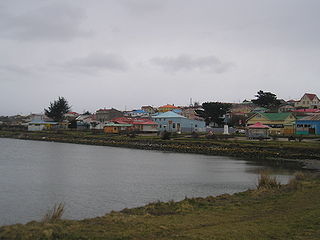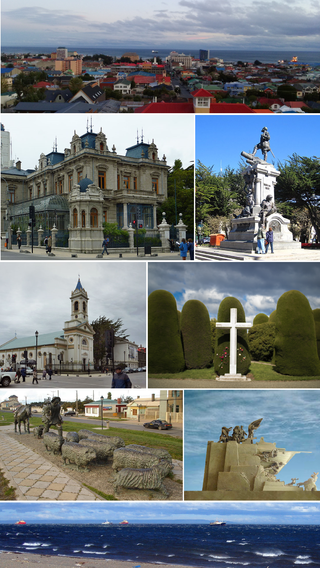
Tierra del Fuego is an archipelago off the southernmost tip of the South American mainland, across the Strait of Magellan.

The Magallanes Region, officially the Magallanes y la Antártica Chilena Region, is one of Chile's 16 first order administrative divisions. It is the southernmost, largest, and second least populated region of Chile. It comprises four provinces: Última Esperanza, Magallanes, Tierra del Fuego, and Antártica Chilena.

Porvenir is the capital of both the homonymous commune and the Chilean Province of Tierra del Fuego of the Magallanes y la Antártica Chilena Region. It is one of Chile's southernmost towns, and has 4,734 inhabitants, including several thousand soldiers. It is the largest settlement in the Chilean half of the island of Tierra del Fuego.

Miguel Juan Sebastián Piñera Echenique was a Chilean businessman and politician who served as president of Chile from 2010 to 2014 and again from 2018 to 2022. The son of a Christian Democratic politician and diplomat, he studied business administration at the Pontifical Catholic University of Chile and economics at Harvard University. At the time of his death, he had an estimated net worth of US$2.7 billion, according to Forbes, making him the third richest person in Chile and the 1177th richest person in the world.

Punta Arenas is the capital city of Chile's southernmost region, Magallanes and Antarctica Chilena. Although officially renamed as Magallanes in 1927, the name was changed back to Punta Arenas in 1938. The city is the largest south of the 46th parallel south and the most populous southernmost city in Chile and the Americas. Due to its location, it is also the coldest coastal city with more than 100,000 inhabitants in Latin America. Punta Arenas is one of the world's most southerly ports and serves as an Antarctic gateway city.
British Chileans are Chilean residents with fully or partial antecedents from the United Kingdom. The British have been very important in the formation of the Chilean nation. They include Chileans of English, Scottish, Ulster Scots, (Northern) Irish and Welsh ancestry. The numbers of Scottish and Welsh are higher in Patagonia, in Aysén and Magallanes regions. The highest percentage of British Chileans is found in Punta Arenas, followed by Santiago, Valparaíso, Concepcion, Viña del Mar and Antofagasta.
Chile represents one of the largest undeveloped geothermal areas of the world. Despite Chile's good economic performance in the late 1980s and 1990s, geothermal energy did not develop, and Chile has been surpassed by other Latin American countries such as El Salvador and Costa Rica in terms of geothermal development and technology. Currently, Chile has only one geothermal power plant.

Ricardo Jorge Raineri Bernain is an economist, academic, researcher, consultant, and politician. On February 9, 2010, Chile's then President Sebastián Piñera nominated him to the Ministry of Energy.

The 2011–2013 Chilean protests – known as the Chilean Winter or the Chilean Education Conflict – were a series of student-led protests across Chile, demanding a new framework for education in the country, including more direct state participation in secondary education and an end to the existence of profit in higher education. Currently in Chile, only 45% of high school students study in traditional public schools and most universities are also private. No new public universities have been built since the end of the Chilean transition to democracy in 1990, even though the number of university students has increased.

The 2010 Pichilemu earthquakes, also known as the Libertador O'Higgins earthquakes, were a pair of intraplate earthquakes measuring 6.9 and 7.0 that struck Chile's O'Higgins Region on 11 March 2010 about 16 minutes apart. The earthquakes were centred 15 kilometres (9.3 mi) northwest of the city of Pichilemu.

Carolina Nevenka Goić Borojević is a Chilean politician who served as president of the Chilean Christian Democratic Party (PDC) from 2016 to 2017.
Mateo Martinić Beroš is a Chilean historian, politician and lawyer of Croatian descent. He has primarily dealt with the history of the Magallanes Region. He entered the University of Chile in 1953 studying briefly pedagogy before moving on to study law and then continued his law studies in the Catholic University of Chile. He finally became a lawyer in 1983. From 1964 to 1970 he served as intendant of Magallanes Region. He received the National History Award in 2000.

Gabriel Boric Font is a Chilean politician serving as the president of Chile since 11 March 2022. He previously served two four-year terms as a deputy in the Chamber of Deputies.

Federación Obrera de Magallanes was a trade union movement based in Punta Arenas, Chile, active between 1911 and the mid-1920s. FOM was targeted in a deadly arson attack in 1920.

Sara Braun was a Latvian-born Chilean businesswoman who became one of the principal employers in Patagonia. After emigrating with her family from the Russian Empire to escape persecution because of their Jewish heritage, the family toured Europe and then looked for work in Argentina and Paraguay, before moving to Magallanes, now known as Punta Arenas, in 1874.

A series of massive demonstrations and severe riots, known in Chile as the Estallido Social, originated in Santiago and took place in all regions of Chile, with a greater impact in the regional capitals. The protests mainly occurred between October 2019 and March 2020, in response to a raise in the Santiago Metro's subway fare, a probity crisis, cost of living, university graduate unemployment, privatisation, and inequality prevalent in the country.

The worldwide pandemic of coronavirus disease 2019 caused by severe acute respiratory syndrome coronavirus 2 severely affected Chile. The virus was confirmed to have reached Chile on 3 March 2020. Initial cases had been imported from Southeast Asia and Europe, and expanded into a large number of untraceable infections, placing the country within phase 4 of the pandemic as defined by the World Health Organization, with over 1,000 confirmed cases by 25 March 2020.

The 2019–2020 Chilean protests are characterised by widespread eye injuries, including many globe ruptures, among protesters as result of Chilean riot police's use of rubber bullets and tear gas grenades. Data from the National Institute of Human Rights (INDH) shows that the use of rubber bullets and pellets by security forces has left at least 1,863 injured, including 268 with eye problems. According to the Chilean Ophthalmology Society, this is the highest number of injuries of this type registered during protests or in conflict zones in the world. In late November, security forces announced the suspension of the use of rubber pellets as a crowd control method in the protests. The INDH updated figures at the end of January 2020 reporting that 427 persons had received eye injuries at the hands of the police. Almost 90% of the injured are men. As of early January 2020 the age of injured goes from 14 to 59 years, and averages 28 years.

Mario Alberto Rozas Córdova is a Chilean Carabineros officer, who was general director of that institution from December 22, 2018, to November 19, 2020.

José Adolfo Fernández Dübrock is a Chilean forest engineer and politician of German descent. Between 2019 and 2020 he served as Mayor of the Region of Magallanes and Chilean Antarctica, under the second government of Sebastián Piñera.


![Stylized version of the Magallanes y la Antartica Chilena Region flag, saying "No to the increase of gas [prices] in Magallanes." No al alza del gas en Magallanes.jpg](http://upload.wikimedia.org/wikipedia/commons/thumb/4/46/No_al_alza_del_gas_en_Magallanes.jpg/220px-No_al_alza_del_gas_en_Magallanes.jpg)
















